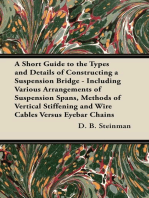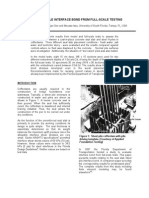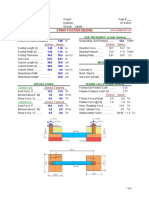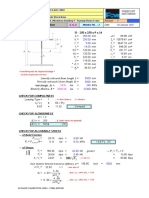SKYWALK1
SKYWALK1
Uploaded by
Larry LoCopyright:
Available Formats
SKYWALK1
SKYWALK1
Uploaded by
Larry LoCopyright
Available Formats
Share this document
Did you find this document useful?
Is this content inappropriate?
Copyright:
Available Formats
SKYWALK1
SKYWALK1
Uploaded by
Larry LoCopyright:
Available Formats
JFAPBC (2006) 2:5-11 © ASM International
DOI: 10.1361/154770206X99271 1547-7029 / $19.00
C • A • T • A• S • T • R • O • P • H • E by Charles R. Morin and Chad R. Fischer
Kansas City Hyatt Hotel Skyway Collapse
In July 1981, two of three skywalks in the atrium of the Hyatt Hotel located in Kansas
City, Mo., collapsed, resulting in 113 deaths and 186 injuries. This catastrophic loss has
been the subject of numerous investigative reports, news specials, and engineering reviews.
This paper briefly reviews the facts and circumstances leading up to the failure so that readers
will better appreciate the problems that arose from the complex interactions between design,
specifications, construction, and quality control. Finally, the question of “Do we really learn
from our mistakes?” is explored.
Introduction
On July 17, 1981, two of the three suspended walkways in
the Kansas City Hyatt Regency Hotel experienced a structural
failure and collapsed. Those injured as a result of the failure
included people dancing in the atrium area, as well as a number
of observers standing on the walkways watching the events
below. As a result of this well-known event, 113 people were
killed and nearly 200 others were injured. Numerous post-
failure analyses have been written and television programs have
been aired addressing both the technical and human interest
aspects of this catastrophe. This paper summarizes the
technical cause of the failure of the critical structural
connections between the support rods and the skywalk bridges
and explores the larger issue as to why the mistakes were made.
Mistakes of this sort are, in principle, avoidable, but when
they occur they should serve as a learning opportunity and
help make our complex world safer. While we must continue
to expect reasonable standards of care to be exercised in
development projects, it is the opinion of the authors that
because of the nature of complex systems, there is no simple
way to assure that the risk of such losses has been minimized.
Critical analysis and periodic re-examination of such matters
providethe framework for learning and improvement. Better
communications and effective teamwork are keys to continued
progress in these matters.
Failure Mode Analysis
The post-failure investigation of this collapse has been well
documented.[1-7] The photographs, diagrams and technical
data contained herein have been largely obtained from the
U.S. Government’s National Bureau of Standards (NBS) (now
known as National Institute of Standards and Technology, or Fig. 1 Schematic view of the walkway bridges spanning the
NIST) investigation. One of the authors (Morin), retained atrium of hotel
Journal of Failure Analysis and Prevention Volume 6(2) April 2006 5
Kansas City Hyatt Hotel Skyway Collapse (continued)
by a representative of the architect, skywalk at the third floor remained Fig. 4. The box beams were con-
personally examined the wreckage in supported (Fig. 2 and 3). People were structed by seam welding two chan-
place and managed a team of spec- standing on all three skywalks and nel sections together at the toes of the
ialists to help determine the root many others were gathered in the inward facing flanges.
cause(s) of the failure. atrium area below the walkways when
the accident occurred. As a direct re- The as-built connection signifi-
A schematic view of the walkway cantly increased the “punching” effect
sult of the collapse, 113 people were
bridges spanning the atrium of the of the upper support rod, because it
killed and 186 were injured.
Hyatt Regency Hotel is shown in Fig.
had to support the total weight of
1. The architectural concept for the The walkways were supported by
both the fourth floor and second floor
bridges, or “skywalks,” was for the steel rods attached to roof trusses
above. The rods then passed through skywalks. In the original concept, one
structure to evoke an open and free-
feeling experience for pedestrians of box beams where nuts and washers longer rod was to have been threaded
the skywalks, thus producing a feeling were installed below the crossbeams over half of its length so that each box
“like walking through the sky.” This to resist the loads. The structural de- beam connection would carry only its
necessitated a structural support sys- tail for the rod-to-beam connection proportionate share of load from a
tem that was slender and lightweight. contemplated by the structural engi- single walkway. As it turned out, the
neer-of-record (EOR) as contrasted change from the original concept was
The failure resulted in the collapse
with the as-built detail is shown in a flaw.
of the skywalks spanning the atrium
at the second and fourth floors. The
Fig. 3 Fourth floor to ceiling hanger rods (right). Third floor walkway still
supported (left)
Fig. 2 Walkways shortly after the collapse Fig. 4 Comparison of as-built and original hanger rod details
6 Volume 6(2) April 2006 Journal of Failure Analysis and Prevention
Soon after the accident, it was clear failure site was traced to location 9 uplift force of the rod had acted to
that the direct cause of the collapse Upper East (9UE) as shown in Fig. create a situation of opening-mode
was due to the support rods pulling 5. Other similar connections exhib- bending on the root of the seam weld
free of the box beams (Fig. 5 and 6). ited many of the same basic failure of the lower surface of the box beam.
By studying the pattern of defor- characteristics. Cracks or cracklike features were ob-
mations of the various sections of the Figure 7 illustrates the post-acci- served at the seam weld root. The
fallen skywalk segments, the initial dent condition of the lower threaded amount of fusion of the weld was
end of a support rod with the nut and typically fairly good (Fig. 10). It was
washer still in place. Figure 8 shows noted that the root side of a partial
the type of impression made by the penetration weld is known to be im-
washer (A) and nut (B) when the rod perfect and relatively easily torn (Fig.
pulled through the lower surface of 10), as compared to a butt or filet
the box beam. weld joint that has been welded from
For comparison, Fig. 9 shows an un- both sides. To make matters worse,
failed connection from the third floor the local area where the nut seated
skywalk. It is readily apparent that the was not reinforced by a bearing pad,
and the box beam side walls were not
reinforced with web stiffeners, nor
Fig. 5 Hanger rod pull-through at location was the open end of the beam fitted
9UE with a close-out plate, any and all of
which would have significantly in-
creased the capacity of this type of
connection.
A load analysis showed that the
connection of interest was subject to
mostly static loading, with the effects
of the added weight of the people and
their movements being relatively
small (Fig. 11). The capacities of the
connections were determined by
calculation and by load testing. The
steady load from the dead weight of
the structure was approximately 90%
Fig. 7 Washer at bottom end of fourth-floor- of the ultimate capacity of the con-
Fig. 6 End view of box beam to-ceiling hanger rod at 9UW nection. Therefore it is likely that
Fig. 8 Impression made by washer on lower surface of box beam Fig. 9 Connection at third floor skywalk that did not collapse
Journal of Failure Analysis and Prevention Volume 6(2) April 2006 7
Kansas City Hyatt Hotel Skyway Collapse (continued)
when the structure was first built nection before it was even put into bowing modes are shown in Fig. 13
some permanent deformation occur- use. The upward bending of the lower and 14, respectively. Note that non-
red in the vicinity of the subject con- flanges of the channel sections, along linear distortion is recorded at loads
with the outward bowing of the webs, as low as approximately 53,400 N
contributed significantly to the root (12 kips, or 12,000 lb). By compar-
side of the lower seam weld being ison to Fig. 11, the failure of the test
pried apart and tearing at the edges segments at applied loads between
of the through-drilled hole where the 71,200 and 89,000 N (16,000 and
rod passed through the beam. 20,000 lb) compared well to the ex-
During the post-failure studies, pected load at the time of the accident
mockups of the connections were of approximately 80,100 to 89,000
tested to failure (Fig. 12). Typical N (18,000-20,000 lb) on each con-
load-deflection curves for the rod nection of the fourth level skywalk.
Fig. 10 Cross section of weld at bottom of box
beam displacement and the beam side wall
How Did It Happen?
The essential nature and sequence
of events was really quite well
understood within the first few hours
of the technical investigation of this
event. The subsequent government
investigation and the investigations
conducted by the various parties
involved took several months, but in
reality, those further investigations
simply provided well-documented
details of what was entirely obvious
from the beginning. If the failure
mode analysis was so easy, why did
the inadequate joint configuration
escape detection during design,
construction, and inspection? In the
authors’ view this question is far more
important than simply understanding
Fig. 11 Comparison of fourth floor walkway box beam-hanger rod connection capacities with loads the failure mode.
believed to have been acting at the time of collapse The project was being built on a
fast track basis. That meant that
portions of the building were already
being built while other parts of the
building were still being designed,
detailed, and approved. This style of
project can pose practical problems
in terms of keeping track of all essen-
tial matters and making sure impor-
tant details are not overlooked. Fast
track construction seemed to be part
of the problem leading to the failure.
The EOR provided the structural
Fig. 12 Test setup for post-failure connection studies steel fabricator with a diagram of how
8 Volume 6(2) April 2006 Journal of Failure Analysis and Prevention
the joint should be arranged (using a two offset rod loads would introduce to understanding what went wrong:
single rod, not the double rod as-built a span-wise bending problem for the • The fast track building process saves
configuration), and he assumed the box beam. The project engineer infor- time and money for the owner, but
fabricator would design the joint mally approved the change without is there time and budget to do all
suitably for the specified load. recognizing that the bearing load on the detailed work that is necessary?
the beam would essentially be
The fabricator subcontracted the • Aren’t mistakes more likely to arise
doubled at the critical location of the
detailing of the joints to another when one is being rushed, especially
beam. After that very limited review,
subcontractor, who took the design at when confronted with new or
the change went forward.
“face value” and simply adapted the innovative configurations where an
conceptual sketch into a shop It was customary in the Midwest
experience-based approach may not
drawing. The shop drawings, by all for steel fabricators to use structural
be available?
rights, should be a reflection of the steel detailers to design suitable con-
final, approved design drawings. In nections. In most instances, this • Communication and teamwork are
this case the joint was never actually requires relatively simple reference to important. Safety and efficiency are
“designed,” because it never was design tables or use of longstanding enhanced when the team (i.e.,
subjected to any kind of engineering custom and practice for typical owner, architect, engineer, contrac-
analysis as to its suitability for its connections. Unique details are ex- tor) has successfully worked together
intended function. Because the pected to be treated differently. Be- in the past.
original configuration would have cause this was not a typical connection, The root cause of the collapse of
required threading the rods half way, structural calculations and a purpose- the skywalk, in the authors’ view, was
the steel fabricator asked the project ful design study should have been the lack of engineering attention to
engineer (who reported to the EOR) completed. Even a rudimentary de- detail in a critical joint. This, coupled
if the double rod configuration would sign review should have alerted the with a misplaced reliance on another
be approved as a change to facilitate engineers that the joint would simply entity to provide the necessary engi-
construction. The project engineer not work. neering input, and the inherent prob-
simply looked at the proposed change In this case, the following factors lem of dealing with complex project
from the standpoint of whether the and questions arise as being important management and approval issues in
Fig. 13 Typical load deflection curves for rod displacement Fig. 14 Typical out-of-plane load displacement curves for box beam web
Journal of Failure Analysis and Prevention Volume 6(2) April 2006 9
Kansas City Hyatt Hotel Skyway Collapse (continued)
the fast track setting, increased the risk not yet been finalized. Numerous mission to protect the public and not
of mistakes being overlooked and change orders and approvals and to punish engineers. However, due to
uncorrected. revisions to plans are inherent in fast the nature of the event, they felt it
track construction, which greatly was necessary for them to review the
Design and Construction complicates an already complicated case. During the State of Missouri
Issues process. A successful project comple- Licensing Board hearings, several
It would be hoped that after such tion can only be realized with timely arguments were made and investi-
a significant disaster many changes and effective communication among gated. One such argument was
would have been implemented to the owner/architect/engineer/contrac- whether the structural EOR was re-
prevent such an event from occurring tor/supplier team. sponsible for checking every steel
again; however, this has not necessarily connection on the project. At least
been the case. The construction Legal Ramifications one engineer testified that he per-
industry naturally evolves with time, While the technical cause of the sonally ran calculations for each con-
but few procedural changes in the Hyatt walkway collapse was very clear, nection shown on the shop drawings.
design and construction process can the determination of who was at fault Other engineers testified that they
be directly attributed to the Hyatt was less clear. The post-failure inves- relied on the expertise of the fabricator
skyway collapse. tigation resulted in conflicting ac- to design connections and only spot
counts of how the in- checked the connection designs.
“As is a common theme with most engineering adequate hanger rod– After these and many other testi-
disasters, a lack of communication can usually to-beam joint configur- monies, the ultimate decision by the
be traced as one of the root causes.” ation was developed and State of Missouri was that the engi-
why it avoided detec- neers were found guilty of gross negli-
tion. Table 1 is a sum- gence and misconduct and the licenses
In general terms, an owner hires an of the EOR and the project engineer
mar y of the investigations and
architectural professional to design a were revoked.
disciplinary actions that took place.
building project so that it meets the
Later, the American Society of
owner’s criteria for form and function Following the collapse, civil lawsuits
Civil Engineers (ASCE) also held a
within a certain allotted budget. The and insurance claims were settled out
disciplinary hearing. The Society had
structural engineer-of-record (EOR) of court for approximately $100
not previously disciplined any of its
is given responsibility for the detailed million. A grand jury investigation
members and instead acted only as a
design aspects related to the structural found there was insufficient evidence
professional society that promoted
elements in accordance with the to charge anyone involved in the
the industry. Just a few years prior to
architectural plans. The general con- construction with criminal negli-
the collapse, ASCE had significantly
tractor will manage the construction gence, and no criminal charges were
revised its Code of Ethics. In 1985,
phase, including procurement of ever filed.
an ASCE board found the EOR
materials and equipment necessary to
Traditionally, the State of Missouri “vicariously responsible… but not
build the building on time and on
Licensing Board had promoted its guilty of gross negligence nor unpro-
budget. In the Midwest, the struc-
tural steel fabricator (which is some-
times also the subcontractor for the Table 1 Summary of Investigations and Disciplinary Actions
supply and erection of the steel) com- Date Action
monly provides the connection details July 1981 Skywalks collapse.
by providing the shop drawings for 1981-83 Civil suits settled out of court for approximately $100 million.
each part of the structure. Because the 1983 Grand jury investigation resulted in “no true bill,” i.e., not enough
Kansas City Hyatt project was a fast evidence to prove gross negligence or criminal wrongdoing.
track project, the construction of 1984 State of Missouri hearing resulted in revocation of engineer-of-record
portions of the building were already and project engineer licenses.
underway while the detailed design 1985 ASCE suspended engineer-of-record membership for three years; the
project engineer was not an ASCE member.
of other portions of the building had
10 Volume 6(2) April 2006 Journal of Failure Analysis and Prevention
fessional conduct” for the error in the The calculations for each connection orative effort between designers,
connection and shop drawing process. are attached to each connection in the contractors, and fabricators. Good
As a result, his ASCE membership computer model and can be seen by engineering design and execution
was suspended for three years. The clicking on individual locations in the often goes unnoticed; mistakes can
project engineer was not an ASCE structure. In addition, the connections result in dire consequences, and the
member and no disciplinary actions are graphically shown in the computer Hyatt skyway collapse is an excellent
could be taken against him. model. This technology is developing example of the consequences of a
The American Institute of Steel rapidly. Of course there are some “simple mistake.”
Construction (AISC) has published administrative challenges such as who
the Code of Standard Practice for Steel has ultimate ownership of the digital References
files. However, as these kinks get 1. R.D. Marshal et al.: “Investigation of the
Buildings and Bridges since 1924. The Kansas City Hyatt Regency Walkways
Code of Standard Practice is intended worked out, these types of innovations
Collapse,” Center for Building Technology,
to provide a “framework for a com- should pave the way for a more effi- National Bureau of Standards, May 1982.
mon understanding of acceptable cient and safer review of engineering 2. G.P. Luth: “Chronology and Context of
standards when contracting for struc- and shop drawings and improve the Hyatt Regency Collapse,” J. Perform.
tural steel construction.” The Code communication between all team Constr. Fac., May 2000, 14(2).
underwent its third complete revision members. 3. J.D. Gillum: “The Engineer of Record and
Design Responsibility,” J. Perform. Constr.
in 1986.
Conclusion Fac., May 2000, 14(2).
As is a common theme with most 4. E.A. Banset and G.M. Parsons: “Com-
In conclusion, few procedural
engineering disasters, a lack of com- munications Failure in Hyatt Regency
changes to the structural design and Disaster,” J. Prof. Iss. Eng-ASCE, 1989,
munication can usually be traced as
construction process were imple- 115(3).
one of the root causes. During the
mented directly as a result of the 5. P.D. Moncarz and R.K. Taylor: “Engi-
State of Missouri investigation, it was
Hyatt skyway collapse. However, the neering Process Failure—Hyatt Walkway
reported by The New York Times that Collapse,” J. Perform. Constr. Fac., May
authors believe the engineering pro-
Duncan (EOR) and Gillum (project 2000, 14(2).
fession and the various states’ Boards
engineer) “had told the board the acci- 6. G.P. Luth: “Chronology and Context of
of Professional Registration have
dent was the result of poor communi- the Hyatt Regency Collapse,” J. Perform.
become much more proactive over the Constr. Fac., May 2000, 14(2).
cation” rather than negligence or
last 30 years. The skyway failure
malpractice. 7. S.K.A. Pfatteicher: “The Hyatt Horror:
initiated a healthy, industry-wide Failure and Responsibility in American
Changes in the future that may focus on the professional respon- Engineering,” J. Perform. Constr. Fac., May
make shop drawing review easier and sibility of the EOR in such matters. 2000, 14(2).
more thorough, along with improving It is also apparent that the con- 8. Design Data, Lincoln, Nebr.: www.
communication between design and struction industry has evolved and sds2.com.
construction teams, include three- continues to evolve with technology 9. Tekla Corporation, Espoo, Finland: www.
and changes in business and develop- xsteel.com.
dimensional (3-D) modeling pro-
grams such as XSteel[8] and SDS/2.[9] ment relationships. An important
Such programs use the original lesson to be learned from the skyway
computer model developed by the collapse is that good communication Charles R. Morin, P.E., and Chad
structural engineer, modeling it as 3- between designers, contractors, and R. Fischer, S.E., P.E., Engineering
D graphics. The computer model can fabricators is paramount for a success- Systems Inc., 3851 Exchange Ave.,
then be transferred to the fabricator/ ful project. Recent software advances Aurora, IL 60504. Contact e-mail:
detailer who can design each con- with 3-D modeling and design pro- crmorin@esi-il.com.
nection directly within the model. grams should improve the collab-
Journal of Failure Analysis and Prevention Volume 6(2) April 2006 11
You might also like
- PRESENTATION John Kulicki Part Bridge Design Specs HistoryNo ratings yetPRESENTATION John Kulicki Part Bridge Design Specs History71 pages
- A Short Guide to the Types and Details of Constructing a Suspension Bridge - Including Various Arrangements of Suspension Spans, Methods of Vertical Stiffening and Wire Cables Versus Eyebar ChainsFrom EverandA Short Guide to the Types and Details of Constructing a Suspension Bridge - Including Various Arrangements of Suspension Spans, Methods of Vertical Stiffening and Wire Cables Versus Eyebar ChainsNo ratings yet
- Synopsis - Kansas City Hyatt Regency Walkways CollapseNo ratings yetSynopsis - Kansas City Hyatt Regency Walkways Collapse7 pages
- Design of Braced Frames in Opern Building For Wind LoadingNo ratings yetDesign of Braced Frames in Opern Building For Wind Loading10 pages
- Dynamic Passive Pressure From C - Soil Backfills - Shukla, Habibi - 2011-AnnotatedNo ratings yetDynamic Passive Pressure From C - Soil Backfills - Shukla, Habibi - 2011-Annotated4 pages
- Technical Aid 1 Shelf Angle and Brick Ledge Design Rev 4No ratings yetTechnical Aid 1 Shelf Angle and Brick Ledge Design Rev 418 pages
- Advanced Design of Concrete Structures - UPCNo ratings yetAdvanced Design of Concrete Structures - UPC5 pages
- Design of Reinforced Concrete Columns PDFNo ratings yetDesign of Reinforced Concrete Columns PDF9 pages
- Storage Building Type I: Structural Steel Design Calculation SheetNo ratings yetStorage Building Type I: Structural Steel Design Calculation Sheet1 page
- Tension Flange Effective Width in Reinforced Concrete Shear Walls PDFNo ratings yetTension Flange Effective Width in Reinforced Concrete Shear Walls PDF8 pages
- Hybrid Concrete Masonry Design: TEK 14-9ANo ratings yetHybrid Concrete Masonry Design: TEK 14-9A8 pages
- Brace Forces in Steel Box Girders With Single Diagonal Lateral Bracing SystemsNo ratings yetBrace Forces in Steel Box Girders With Single Diagonal Lateral Bracing Systems12 pages
- Bibliography - Helical Piles A Practical Guide To Design and Installation PDFNo ratings yetBibliography - Helical Piles A Practical Guide To Design and Installation PDF17 pages
- Seal Slab Steel Pile Inface Bond From Full Scale Testing100% (1)Seal Slab Steel Pile Inface Bond From Full Scale Testing11 pages
- The Design Procedures For Prestressed Reinforced Concrete100% (1)The Design Procedures For Prestressed Reinforced Concrete87 pages
- On Seismic Design of Retaining Walls: Yingwei Wu Shamsher Prakash Vijay K. PuriNo ratings yetOn Seismic Design of Retaining Walls: Yingwei Wu Shamsher Prakash Vijay K. Puri8 pages
- Seismic Analysis and Design of Structures Using Response Spectra Time History MotionsNo ratings yetSeismic Analysis and Design of Structures Using Response Spectra Time History Motions60 pages
- STRUCTURE Magazine - Steel Deck Diaphragm Design 101No ratings yetSTRUCTURE Magazine - Steel Deck Diaphragm Design 1016 pages
- Jack Pesch Bicycle and Pedestrian Bridge (QLD)No ratings yetJack Pesch Bicycle and Pedestrian Bridge (QLD)4 pages
- Reinforcing Steel in Slabs On Grade - tcm45-346883No ratings yetReinforcing Steel in Slabs On Grade - tcm45-3468833 pages
- New Fatigue Provisions For The Design of Crane Runway GirdersNo ratings yetNew Fatigue Provisions For The Design of Crane Runway Girders9 pages
- (2020) Experimental Testing of Innovative Panel-To-Panel Connections For PrecastNo ratings yet(2020) Experimental Testing of Innovative Panel-To-Panel Connections For Precast15 pages
- AISC Design Guide 11 - Errata 2009-06-01 PDFNo ratings yetAISC Design Guide 11 - Errata 2009-06-01 PDF4 pages
- Conflicting Missions Havana Washington and Africa 1959 1976 1st Edition Piero Gleijeses 2024 scribd download100% (2)Conflicting Missions Havana Washington and Africa 1959 1976 1st Edition Piero Gleijeses 2024 scribd download81 pages
- Effects of Transverse Reinforcement On Seismic Performance of ColumnsNo ratings yetEffects of Transverse Reinforcement On Seismic Performance of Columns9 pages
- Chartek 1709 Protecting Lives, Protecting Assets BrochureNo ratings yetChartek 1709 Protecting Lives, Protecting Assets Brochure2 pages
- Modification of Mononobe Okabe Theory PDFNo ratings yetModification of Mononobe Okabe Theory PDF3 pages
- Architecture Basics: Arches: Elements of The ArchNo ratings yetArchitecture Basics: Arches: Elements of The Arch3 pages
- The Tower and the Bridge: The New Art of Structural EngineeringFrom EverandThe Tower and the Bridge: The New Art of Structural Engineering4.5/5 (6)
- Analysis and Design of Commercial BuildiNo ratings yetAnalysis and Design of Commercial Buildi7 pages
- Industrial Floor Framing For Vibrating Equipment: Ernest L. Klaber, P.ENo ratings yetIndustrial Floor Framing For Vibrating Equipment: Ernest L. Klaber, P.E44 pages
- Full Download Structural analysis of multi storey buildings Second Edition K. A. Zalka PDF DOCXNo ratings yetFull Download Structural analysis of multi storey buildings Second Edition K. A. Zalka PDF DOCX60 pages
- Advanced Design of Steel and Concrete Composite StructuresNo ratings yetAdvanced Design of Steel and Concrete Composite Structures42 pages
- Precast Concrete Floor Slabs - Concrete Manufacturers Association (South Africa - 1999)No ratings yetPrecast Concrete Floor Slabs - Concrete Manufacturers Association (South Africa - 1999)37 pages
- Chapter 3 Shear Force and Bending Moment in BeamsNo ratings yetChapter 3 Shear Force and Bending Moment in Beams8 pages
- The Development of A New Design Procedure For Conventional Single-Plate Shear ConnectionsNo ratings yetThe Development of A New Design Procedure For Conventional Single-Plate Shear Connections12 pages
- 114 TOP Design of Steel Structures - Civil Engineering Multiple Choice Questions and Answers List - MCQs Preparation For Engineering Competitive Exams50% (2)114 TOP Design of Steel Structures - Civil Engineering Multiple Choice Questions and Answers List - MCQs Preparation For Engineering Competitive Exams12 pages
- Reinforced Concrete Eccentric Beam-Column Connections Subjected To Earthquake-Type LoadingNo ratings yetReinforced Concrete Eccentric Beam-Column Connections Subjected To Earthquake-Type Loading11 pages
- Paper WCTE HAMM Floor Vibrations New ResultsNo ratings yetPaper WCTE HAMM Floor Vibrations New Results10 pages
- Strap Footing Design: ASDIP Foundation 4.4.2No ratings yetStrap Footing Design: ASDIP Foundation 4.4.24 pages
- Aitc - 119-96 American Institute of Timber Construction PDF100% (1)Aitc - 119-96 American Institute of Timber Construction PDF39 pages
- CUSAT Old Syllabus-Mechanical EngineeringNo ratings yetCUSAT Old Syllabus-Mechanical Engineering61 pages
- PRESENTATION John Kulicki Part Bridge Design Specs HistoryPRESENTATION John Kulicki Part Bridge Design Specs History
- A Mathematical Study of Cantilever Bridge DesignFrom EverandA Mathematical Study of Cantilever Bridge Design
- A Short Guide to the Types and Details of Constructing a Suspension Bridge - Including Various Arrangements of Suspension Spans, Methods of Vertical Stiffening and Wire Cables Versus Eyebar ChainsFrom EverandA Short Guide to the Types and Details of Constructing a Suspension Bridge - Including Various Arrangements of Suspension Spans, Methods of Vertical Stiffening and Wire Cables Versus Eyebar Chains
- Synopsis - Kansas City Hyatt Regency Walkways CollapseSynopsis - Kansas City Hyatt Regency Walkways Collapse
- Design of Braced Frames in Opern Building For Wind LoadingDesign of Braced Frames in Opern Building For Wind Loading
- Dynamic Passive Pressure From C - Soil Backfills - Shukla, Habibi - 2011-AnnotatedDynamic Passive Pressure From C - Soil Backfills - Shukla, Habibi - 2011-Annotated
- Technical Aid 1 Shelf Angle and Brick Ledge Design Rev 4Technical Aid 1 Shelf Angle and Brick Ledge Design Rev 4
- Storage Building Type I: Structural Steel Design Calculation SheetStorage Building Type I: Structural Steel Design Calculation Sheet
- Tension Flange Effective Width in Reinforced Concrete Shear Walls PDFTension Flange Effective Width in Reinforced Concrete Shear Walls PDF
- Brace Forces in Steel Box Girders With Single Diagonal Lateral Bracing SystemsBrace Forces in Steel Box Girders With Single Diagonal Lateral Bracing Systems
- Bibliography - Helical Piles A Practical Guide To Design and Installation PDFBibliography - Helical Piles A Practical Guide To Design and Installation PDF
- Seal Slab Steel Pile Inface Bond From Full Scale TestingSeal Slab Steel Pile Inface Bond From Full Scale Testing
- The Design Procedures For Prestressed Reinforced ConcreteThe Design Procedures For Prestressed Reinforced Concrete
- On Seismic Design of Retaining Walls: Yingwei Wu Shamsher Prakash Vijay K. PuriOn Seismic Design of Retaining Walls: Yingwei Wu Shamsher Prakash Vijay K. Puri
- Seismic Analysis and Design of Structures Using Response Spectra Time History MotionsSeismic Analysis and Design of Structures Using Response Spectra Time History Motions
- STRUCTURE Magazine - Steel Deck Diaphragm Design 101STRUCTURE Magazine - Steel Deck Diaphragm Design 101
- Reinforcing Steel in Slabs On Grade - tcm45-346883Reinforcing Steel in Slabs On Grade - tcm45-346883
- New Fatigue Provisions For The Design of Crane Runway GirdersNew Fatigue Provisions For The Design of Crane Runway Girders
- (2020) Experimental Testing of Innovative Panel-To-Panel Connections For Precast(2020) Experimental Testing of Innovative Panel-To-Panel Connections For Precast
- Conflicting Missions Havana Washington and Africa 1959 1976 1st Edition Piero Gleijeses 2024 scribd downloadConflicting Missions Havana Washington and Africa 1959 1976 1st Edition Piero Gleijeses 2024 scribd download
- Effects of Transverse Reinforcement On Seismic Performance of ColumnsEffects of Transverse Reinforcement On Seismic Performance of Columns
- Chartek 1709 Protecting Lives, Protecting Assets BrochureChartek 1709 Protecting Lives, Protecting Assets Brochure
- Zone Leader: 7 Tactics for Leading in the ZonesFrom EverandZone Leader: 7 Tactics for Leading in the Zones
- Crossroads in Time Philby and Angleton A Story of TreacheryFrom EverandCrossroads in Time Philby and Angleton A Story of Treachery
- The Tower and the Bridge: The New Art of Structural EngineeringFrom EverandThe Tower and the Bridge: The New Art of Structural Engineering
- Industrial Floor Framing For Vibrating Equipment: Ernest L. Klaber, P.EIndustrial Floor Framing For Vibrating Equipment: Ernest L. Klaber, P.E
- Full Download Structural analysis of multi storey buildings Second Edition K. A. Zalka PDF DOCXFull Download Structural analysis of multi storey buildings Second Edition K. A. Zalka PDF DOCX
- Advanced Design of Steel and Concrete Composite StructuresAdvanced Design of Steel and Concrete Composite Structures
- Precast Concrete Floor Slabs - Concrete Manufacturers Association (South Africa - 1999)Precast Concrete Floor Slabs - Concrete Manufacturers Association (South Africa - 1999)
- The Development of A New Design Procedure For Conventional Single-Plate Shear ConnectionsThe Development of A New Design Procedure For Conventional Single-Plate Shear Connections
- 114 TOP Design of Steel Structures - Civil Engineering Multiple Choice Questions and Answers List - MCQs Preparation For Engineering Competitive Exams114 TOP Design of Steel Structures - Civil Engineering Multiple Choice Questions and Answers List - MCQs Preparation For Engineering Competitive Exams
- Reinforced Concrete Eccentric Beam-Column Connections Subjected To Earthquake-Type LoadingReinforced Concrete Eccentric Beam-Column Connections Subjected To Earthquake-Type Loading
- Aitc - 119-96 American Institute of Timber Construction PDFAitc - 119-96 American Institute of Timber Construction PDF

























































































